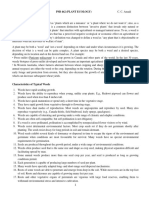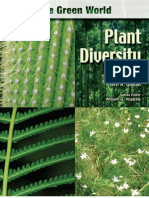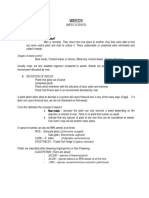Ecological Role: Adaptations
Ecological Role: Adaptations
Uploaded by
Yash ThakkarCopyright:
Available Formats
Ecological Role: Adaptations
Ecological Role: Adaptations
Uploaded by
Yash ThakkarOriginal Description:
Original Title
Copyright
Available Formats
Share this document
Did you find this document useful?
Is this content inappropriate?
Copyright:
Available Formats
Ecological Role: Adaptations
Ecological Role: Adaptations
Uploaded by
Yash ThakkarCopyright:
Available Formats
Ecological role
A dandelion is a common plant all over the world, especially in Europe, Asia, and the Americas. It is a wellknown example of a plant that is considered a weed in some contexts (such as lawns) but not a weed in others (such as when it is used as a leaf vegetable or herbal medicine).
Weeds generally share similar adaptations that give them advantages and allow them to proliferate in disturbed environments where soil or natural vegetative cover has been damaged. Different types of habitat and disturbances will result in colonization by different communities of weed species.[4] Naturally occurring disturbed environments include dunes and other windswept areas with shifting soils, alluvial flood plains, river banks and deltas, and areas that are often burned. Since human agricultural practices often mimic these natural environments where weedy species have evolved, weeds have adapted to grow and proliferate in human-disturbed areas such as agricultural fields, lawns, roadsides, and construction sites. The weedy nature of these species often gives them an advantage over more desirable crop species because they often grow quickly and reproduce quickly, have seeds that persist in the soil seed bankfor many years, or have short lifespans with multiple generations in the same growing season. Perennial weeds often have underground stems that spread out under the soil surface or, like ground ivy (Glechoma hederacea), have creeping stems that root and spread out over the ground.[5] Some plants become dominant when introduced into new environments because the animals which specialize in feeding on them are absent; in what is sometimes called the natural enemies hypothesis, plants freed from these specialist consumers may increase their competitive ability. In locations where predation and mutual competitive relationships no longer exist, some plants are able to increase allocation of resources into growth or reproduction. The weediness of some species that are introduced into new environments may be caused by their production of allelopathic chemicals which indigenous plants are not yet adapted to, a scenario sometimes called the "novel weapons hypothesis". These chemicals may limit the growth of established plants or the germination and growth of seeds and seedlings.[6][7]
Dispersal
This section does not cite any references or sources. Please help improve this section byadding citations to reliable sources. Unsourced material may be challenged and removed.(May 2013) Many weed species have moved out of their natural geographic ranges and spread around the world in tandem with human migrations and commerce. Weed seeds are often collected and transported with crops after the harvesting of grains, so humans are a vector of transport as well as a producer of the disturbed environments to which weed species are well adapted, resulting in many weeds having a close association with human activities.[citation needed] Some weed species have been classified as noxious weeds by government authorities because, if left unchecked, they often compete with native or crop plants or cause harm to livestock. They are often foreign species accidentally or imprudently imported into a region where there are few natural controls to limit their population and spread.
Competition with cultivated and endemic plants
700 cattle that were killed overnight by a poisonous weed.[8]
Weeds may be unwanted for a number of reasons. An important one is that they interfere with food and fiber production in agriculture, wherein they must be controlled in order to prevent lost or diminished crop yields. Other important reasons are that they interfere with other cosmetic, decorative, or recreational goals, such as in lawns, landscape architecture,playing fields, and golf courses. Similarly, they can be of concern for environmental reasons whereby introduced species out-compete for resources or space with desired endemic plants. For all these reasons; horticulture, both functional and cosmetic, and environmental, - weeds interfere by:
competing with the desired plants for the resources that a plant typically needs, namely, direct sunlight, soil nutrients, water, and (to a lesser extent) space for growth; providing hosts and vectors for plant pathogens, giving them greater opportunity to infect and degrade the quality of the desired plants; providing food or shelter for animal pests such as seed-eating birds and Tephritid fruit flies that otherwise could hardly survive seasonal shortages;[9]
offering irritation to the skin or digestive tracts of people or animals, either physical irritation via thorns, prickles, or burs, or chemical irritation via natural poisons or irritants in the weed (for example, the poisons found in Nerium species);[10] causing root damage to engineering works such as drains, road surfaces, and foundations,[11] blocking streams and rivulets.[12]
In weed ecology some authorities speak of the relationship between "the three Ps": plant, place, perception. These have been very variously defined, but the weed traits listed by H.G. Baker are widely cited.[13][14] Weeds have long been a concern, perhaps as long as humans have cultivated plants. They are mentioned in various historic texts, such as a Shakespearean sonnet: "To thy fair flower add the rank smell of weeds: / But why thy odour matcheth not thy show, / The soil is this, that thou dost common grow."[15]
Benefits of weed species
See also: companion plant, beneficial weed, List of beneficial weeds, and list of edible flowers
"What would the world be, once bereft, of wet and wildness? Let them be left. O let them be left; wildness and wet; Long live the weeds and the wilderness yet." -- Gerard Manley Hopkins' poemInversnaid
While the term "weed" generally has a negative connotation, many plants known as weeds can have beneficial properties. A number of weeds, such as the dandelion (Taraxacum), are edible, and their leaves or roots may be used for food or herbal medicine. Burdock is common over much of the world, and is sometimes used to make soup and medicine in East Asia.[citation needed] Some weeds attract beneficial insects, which in turn can protect crops from harmful pests. Weeds can also prevent pest insects from finding a crop, because their presence disrupts the incidence of positive cues which pests use to locate their food. Weeds may also act as a "living mulch", providing ground cover that reduces moisture loss and prevents erosion. Weeds may also improve soil fertility; dandelions, for example, bring up nutrients like calcium and nitrogen from deep in the soil with their tap root, and clover hosts nitrogen-fixing bacteria in its roots, fertilizing the soil directly. The dandelion is also one of several species which break up hardpan in overly cultivated fields, helping crops grow deeper root systems. Some garden flowers originated as weeds in cultivated fields and have been selectively bred for their gardenworthy flowers or foliage. An example of a crop weed that is grown in gardens is the corncockle, (Agrostemma githago), which was a common weed in European wheat fields, but is now sometimes grown as a garden plant.[16]
Some people have appreciated weeds for their tenacity, their wildness and even the work and connection to nature they provide. AsChristopher Lloyd wrote in The Well-Tempered Garden "Many gardeners will agree that hand-weeding is not the terrible drudgery that it is often made out to be. Some people find in it a kind of soothing monotony. It leaves their minds free to develop the plot for their next novel or to perfect the brilliant repartee with which they should have encountered a relative's latest example of unreasonableness."[17] Shunryu Suzuki, the Zen master, is credited with proclaiming, "For Zen students, a weed is a treasure."
Weeds as adaptable species
"We've got to be one of the most bomb-proof species on the planet." paleontologist David Jablonsky[2]
An alternate definition often used by biologists is any species, not just plants, that can quickly adapt to any environment.[2] Some traits of weedy species are the ability to reproduce quickly, disperse widely, live in a variety of habitats, establish a population in strange places, succeed in disturbed ecosystems and resist eradication once established. Such species often do well in human-dominated environments as other species are not able to adapt. Common examples include the common pigeon, brown rat and the raccoon. Other weedy species have been able to expand their range without actually living in human environments, as human activity has damaged the ecosystems of other species. These include the coyote, the white-tailed deer and the brown headed cowbird.[2] In response to the idea that humans may face extinction due to environmental degradation, paleontologist David Jablonsky counters by arguing that humans are a weed species. Like other weedy species, humans are widely dispersed in a wide variety of environments, and are highly unlikely to go extinct no matter how much damage the environment faces.[2]
Role in mass extinctions
A mass extinction is generally caused by some abrupt disruption to the entire planet's environment. This results in major changes in habitat worldwide, and most endemic species, specially adapted to a single habitat, cannot survive in the new habitats. Thus only weedy species survive, and they dominate the planet in the immediate aftermath. Cockroaches, for example, have survived several mass extinctions. The current Holocene extinction event, then, could lead to a planet inhabited entirely by what are known today as weeds. The fossil record indicates that after mass extinctions, a weed-dominated planet persists for five to ten million years before life re-diversifies
You might also like
- Biodiversity: Peak Nature? by Stephanie MillsDocument18 pagesBiodiversity: Peak Nature? by Stephanie MillspermaMediaNo ratings yet
- This Article Is About Plants Specifically Called WeedsDocument5 pagesThis Article Is About Plants Specifically Called WeedsQuin CusayNo ratings yet
- WeedDocument8 pagesWeedcacho cgNo ratings yet
- Cprot Midterm Weeds (1)Document25 pagesCprot Midterm Weeds (1)Khayna LazamNo ratings yet
- Benefits and Loses Caused by WeedsDocument7 pagesBenefits and Loses Caused by WeedsBharaniDeepanNo ratings yet
- 2012 Reviewer in Weed Science - DocDocument75 pages2012 Reviewer in Weed Science - DocRowena Babagonio SarsuaNo ratings yet
- Weed ScienceDocument58 pagesWeed ScienceAngelyn RodulloNo ratings yet
- Compiled Notes WEED SCIENCEDocument30 pagesCompiled Notes WEED SCIENCElordtakyi21No ratings yet
- Vermiculture: Why All The Excitement About Earthworms?Document4 pagesVermiculture: Why All The Excitement About Earthworms?amol Akolkar ( amolpc86)No ratings yet
- PSB 462 - Weed EcologyDocument4 pagesPSB 462 - Weed Ecologyd.orreenselcouthNo ratings yet
- Lecture (1) (E) (502) Sem - 2 M.Sc. (Ag) - AgronomyDocument5 pagesLecture (1) (E) (502) Sem - 2 M.Sc. (Ag) - Agronomyumeshbv.a88No ratings yet
- BIOLOGYDocument12 pagesBIOLOGYgokullallal2404No ratings yet
- Weed Science 2022 TCEPDocument68 pagesWeed Science 2022 TCEPCharles NeilNo ratings yet
- T5 VerdiepingDocument17 pagesT5 Verdiepingniels.vdp23No ratings yet
- AGR 351 - Opt. Simplified notes〽️ PDFDocument76 pagesAGR 351 - Opt. Simplified notes〽️ PDF2020034012dbcaNo ratings yet
- GrassDocument3 pagesGrassJothiarun DhanapalNo ratings yet
- Weed Biology and EcologyDocument113 pagesWeed Biology and Ecologyblessingjosh090100% (1)
- Weed Biology Dille2017Document4 pagesWeed Biology Dille2017Neder BlancoNo ratings yet
- CodaiDocument28 pagesCodaiVuthy CheyNo ratings yet
- Introduction To Parasitic Flowering PlantsDocument31 pagesIntroduction To Parasitic Flowering Plantsgi3'100% (1)
- The Book of Seeds: A Life-Size Guide to Six Hundred Species from Around the WorldFrom EverandThe Book of Seeds: A Life-Size Guide to Six Hundred Species from Around the WorldRating: 4 out of 5 stars4/5 (1)
- Class 8 Zonal PlantDocument6 pagesClass 8 Zonal PlantRitesh SNo ratings yet
- Weeds (Afp)Document94 pagesWeeds (Afp)Chrisz Etrata BibayNo ratings yet
- Weeds As Indicators of Soil Conditions PDFDocument8 pagesWeeds As Indicators of Soil Conditions PDFnikosNo ratings yet
- GrassDocument3 pagesGrassunusannus1stNo ratings yet
- Cover Letter Template General ApplicationDocument4 pagesCover Letter Template General ApplicationM SIREESHANo ratings yet
- Tanaman Alternanthera PhiloxeroidesDocument5 pagesTanaman Alternanthera PhiloxeroidesHartojo GondomuliaNo ratings yet
- Mayaman Is ADocument9 pagesMayaman Is ABayyina Bint BasharyNo ratings yet
- Invasive Alien SpeciesDocument11 pagesInvasive Alien SpeciesAndleeb FatimaNo ratings yet
- Plant Diversity TaxonomyDocument145 pagesPlant Diversity Taxonomyraj1987kapoor9309100% (10)
- Final Presentation Basic Weed Science IIDocument68 pagesFinal Presentation Basic Weed Science IIPhoebe O. TumammanNo ratings yet
- LandscapingBackyards For Wildlife Top Ten Tips For SuccessDocument8 pagesLandscapingBackyards For Wildlife Top Ten Tips For SuccessMirela DragosNo ratings yet
- Weed ScienceDocument89 pagesWeed ScienceChirs Nicole CaguitlaNo ratings yet
- weedDocument100 pagesweedmussabersajid11No ratings yet
- Garden Plants Attractiveness To BeesDocument11 pagesGarden Plants Attractiveness To BeesDan George IonescuNo ratings yet
- Biodiversity PDFDocument67 pagesBiodiversity PDFTanaya BorseNo ratings yet
- Pocket Field Guide To Weeds in KentuckyDocument10 pagesPocket Field Guide To Weeds in KentuckyScottNo ratings yet
- Seed DispersalDocument11 pagesSeed DispersalRaman Khosa100% (1)
- Quantifying Variation Among Garden Plants in Attractiveness To Bees and Other Flower-Visiting InsectsDocument11 pagesQuantifying Variation Among Garden Plants in Attractiveness To Bees and Other Flower-Visiting InsectsFernandoNo ratings yet
- angDocument1 pageangaakashbhatia6b12921No ratings yet
- Cesci 1Document10 pagesCesci 1ryzaherva862No ratings yet
- All About HerbicidesDocument28 pagesAll About Herbicidesmexx4u2nv100% (1)
- Factors Effecting BiodiversityDocument12 pagesFactors Effecting BiodiversityAdnan AliNo ratings yet
- Bte103 l3 AnoDocument39 pagesBte103 l3 Anofarabee.zamanNo ratings yet
- WEEDSDocument53 pagesWEEDSRex DullitNo ratings yet
- Importance of InsectsDocument7 pagesImportance of InsectsMol maharjanNo ratings yet
- Habitat Destruction and Invasive SpeciesDocument3 pagesHabitat Destruction and Invasive Speciesnishana.rampartapNo ratings yet
- Kunkel Et Al-2023Document11 pagesKunkel Et Al-2023NicolasNo ratings yet
- 20 Weed ManagementDocument20 pages20 Weed ManagementthunderhossNo ratings yet
- Cream Cute Kawaii Group Project PresentationDocument12 pagesCream Cute Kawaii Group Project PresentationisisbrennanNo ratings yet
- STS Biodiversity and Human HealthDocument7 pagesSTS Biodiversity and Human HealthChrista JesusaNo ratings yet
- 1943 1945Document19 pages1943 1945wedajeNo ratings yet
- 1848 Ha 99Document17 pages1848 Ha 99Leonides Bernardo Fernández LicónNo ratings yet
- Watermelon: From Wikipedia, The Free EncyclopediaDocument16 pagesWatermelon: From Wikipedia, The Free Encyclopediashwepyi tharNo ratings yet
- Virgin Holidays LimitedDocument5 pagesVirgin Holidays LimitedYash ThakkarNo ratings yet
- Chagas Disease: Chagas Disease, Also Known As American Trypanosomiasis, Is ADocument9 pagesChagas Disease: Chagas Disease, Also Known As American Trypanosomiasis, Is AYash ThakkarNo ratings yet
- History: Main ArticleDocument8 pagesHistory: Main ArticleYash ThakkarNo ratings yet
- History: ChannelnetDocument4 pagesHistory: ChannelnetYash ThakkarNo ratings yet
- Social Networking WebsitesDocument5 pagesSocial Networking WebsitesYash ThakkarNo ratings yet
- Rolling StockDocument6 pagesRolling StockYash ThakkarNo ratings yet
- Statistics: See Also:,, andDocument3 pagesStatistics: See Also:,, andYash ThakkarNo ratings yet
- HistoryDocument8 pagesHistoryYash ThakkarNo ratings yet
- Organisational Structure: Main Article: Further InformationDocument4 pagesOrganisational Structure: Main Article: Further InformationYash ThakkarNo ratings yet
- Index: Sr. No. Particulars NoDocument17 pagesIndex: Sr. No. Particulars NoYash ThakkarNo ratings yet
- End of Dynastic Rule: A 19th-Century Painting Depicting The of 1850-1864Document7 pagesEnd of Dynastic Rule: A 19th-Century Painting Depicting The of 1850-1864Yash ThakkarNo ratings yet
- History of Milk Preservation MethodsDocument3 pagesHistory of Milk Preservation MethodsYash ThakkarNo ratings yet
- AnimationsDocument4 pagesAnimationsYash ThakkarNo ratings yet
- History: RomanDocument10 pagesHistory: RomanYash ThakkarNo ratings yet
- Renewable Energy Is Generally Defined As Energy That Comes FromDocument4 pagesRenewable Energy Is Generally Defined As Energy That Comes FromYash ThakkarNo ratings yet
- Economic Trends: Levelized Cost Solar PV Germany KWHDocument7 pagesEconomic Trends: Levelized Cost Solar PV Germany KWHYash ThakkarNo ratings yet
- Cards Against HumanityDocument32 pagesCards Against HumanityYash ThakkarNo ratings yet
- Mainstream TechnologiesDocument6 pagesMainstream TechnologiesYash ThakkarNo ratings yet
- Insurance IndustryDocument8 pagesInsurance IndustryYash ThakkarNo ratings yet
- Scrap Industry (Glocal)Document6 pagesScrap Industry (Glocal)Yash ThakkarNo ratings yet















































































